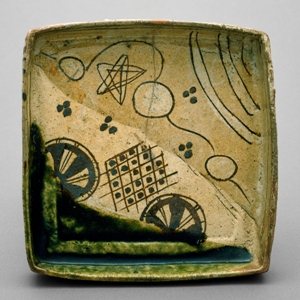SAM Art: Oribe Ware
Writing SAMart this week is Hattie Branch, Blakemore Intern for Japanese Art. This is her second entry in a series focusing on LUMINOUS: The Art of Asia.
Employing vivid colors and energetic, abstract designs, Oribe ware is the most dynamic type of Japanese tea ware. The style takes its name from Furuta Oribe, 1591-1615, the great tea master of his age. Designed for use in the meal accompanying the tea ceremony, a square dish like this would be used to serve fish, slowly revealing the image beneath as the meal was eaten. Oribe ware, as this tray excellently represents, broke with a tradition of elegant restraint to embrace an unprecedented level of vivacity.
This tray is meant to depict water, earth, and sky. We read it from bottom to top:
- Starting in the lower left corner, the tray was dipped into a green glaze which visibly pooled during the firing process, evoking water.
- Moving upward, a pink-tan band provides a bed for two semi-circles with radiating patterns. This common decorative motif represents ox cart wheels soaking in water—wooden cart wheels needed to be soaked regularly to prevent warping. Between the two wheels, the pattern of squares and dots could represent a piece of dyed fabric. These are colors, images and activities associated with the earth.
- The upper-most, tan portion encompasses a single large star, surrounded by three circles with trailing tails, likely comets. In the upper right corner, three arcing stripes abstractly render the long trailing clouds popular in Japanese painting. This band depicts the sky.
The ebullience that makes Oribe ware stand out amid tea ceramics reflects both the power and dynamism of the Momoyama Era (1573-1615), and, amidst political and social upheaval, a move to rebel against previous aesthetic rules, and the power structures they represented.
